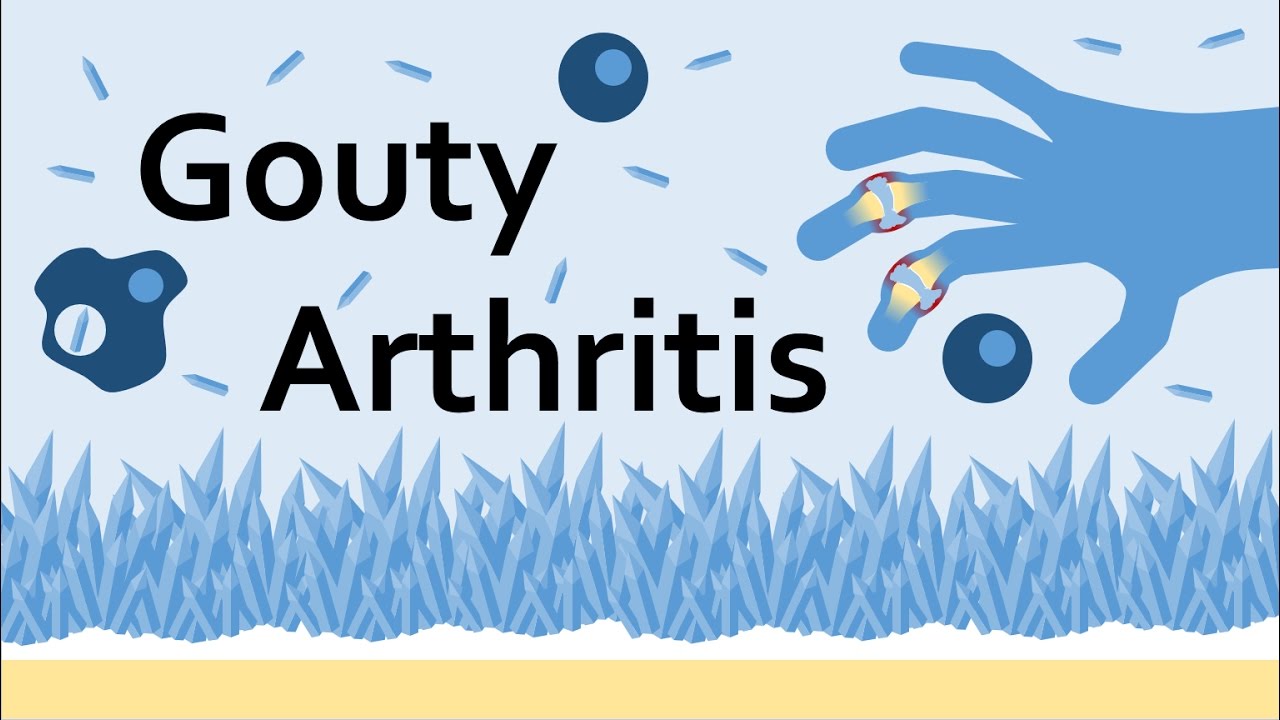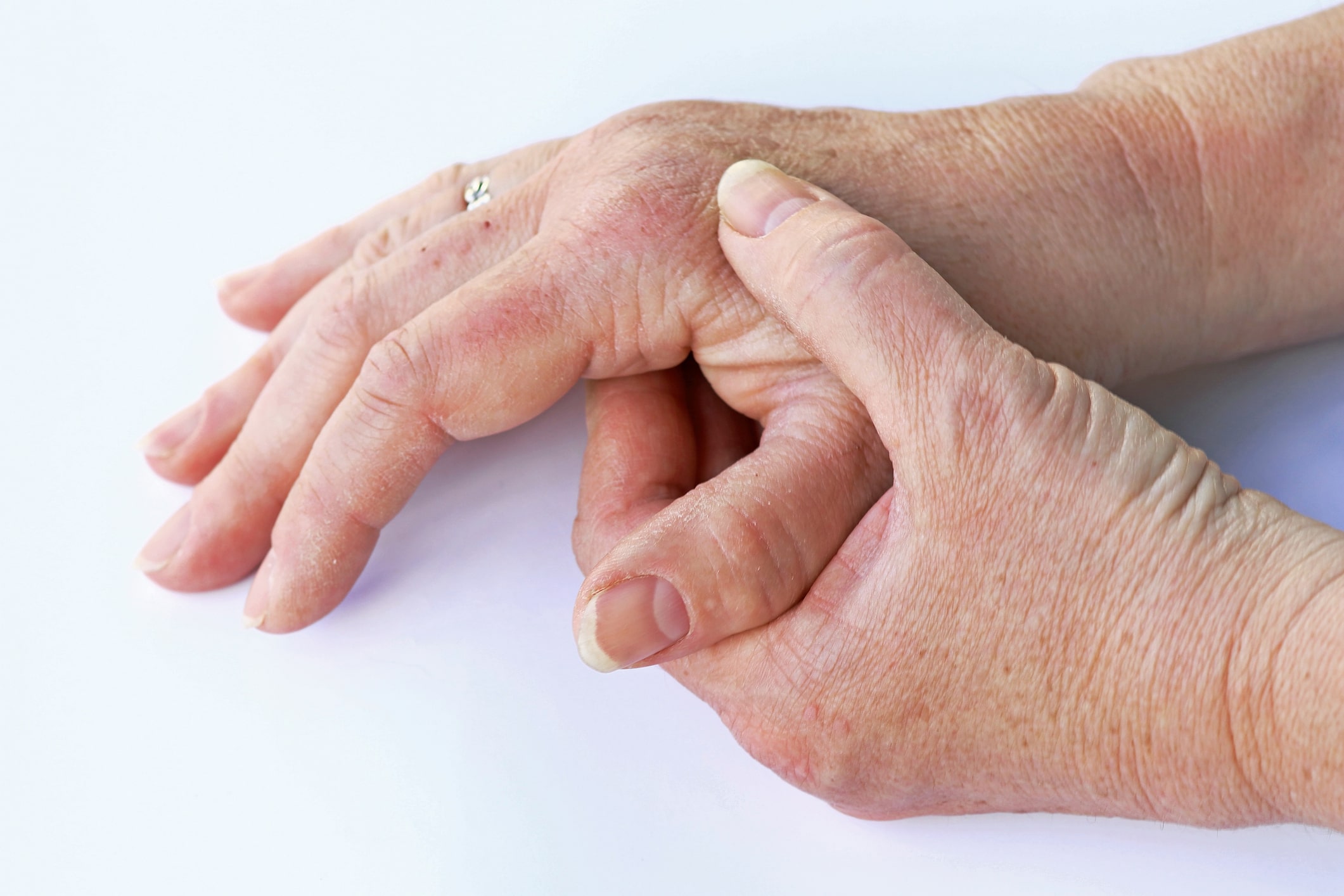Gout - How It Affects The Ederly
Monosodium urate (MSU) crystals accumulate in the tissues of the articular and periarticular surfaces, causing gout. It affects the elderly frequently, with prevalence increasing from 21 per 1000 in 1990 to 41 per 1000 in 1999. Even though gout is typically associated with men, this gender difference begins to disappear after the age of 65, most likely because of hormonal factors. Gout is extremely common in elderly people for a variety of reasons.
Author:Suleman ShahReviewer:Han JuJul 26, 202360 Shares30.1K Views

Monosodium urate (MSU) crystals accumulate in the tissues of the articular and periarticular surfaces, causing gout. It affects the elderly frequently, with prevalence increasing from 21 per 1000 in 1990 to 41 per 1000 in 1999.
Even though gout is typically associated with men, this gender difference begins to disappear after the age of 65, most likely because of hormonal factors. Gout is extremely common in elderly people for a variety of reasons.
The duration of hyperuricemia and, consequently, longevity are both related to the risk of gout.
Hyperuricemia may be triggered by polypharmacy, an increase in cardiovascular, renal, and metabolic morbidity in the elderly that causes a decrease in GFR and reduced uric acid excretion.
Etiopathogenesis
Serum uric acid (SUA) levels over 7.0 mg/dl (450 μmol/L) in men and over 6.0 mg/dl (360 μmol/L) in women are considered to be hyperuricemia. Only 10% of people with hyperuricemia will eventually develop gout, despite the fact that it is a necessary condition. It has been shown that urate lowering therapy(ULT) used to treat hyperuricemia decreases the frequency of acute attacks. This supports the idea that gout and hyperuricemia are related in some way.
The by-product of dietary and endogenous purine metabolism is uric acid. Uric acid is changed into the highly soluble compound allantoin in non-primate animals by the uricase enzyme. Due to the absence of uricase in primates, UA builds up and crystallizes above the physiological saturation limit (about 380 μmol/l or 6.4 mg/dl). Interleukin-1β (IL-1β) is released by monocytes and macrophages in response to crystalline uric acid (MSU), which results in a painful inflammatory arthritis.
Purine intake, de novo synthesis, and its degradation all contribute to the production of uric acid, which is primarily made in the liver (though it can also be made in the small intestines). Since the kidneys account for the majority of excretion, 90% of filtered urate is reabsorbed through the urate transporter (URAT1) in the proximal convoluted tubules, which is a major cause of hyperuricemia.

What is Gout? An Introduction to Gouty Arthritis (1 of 6)
Clinical Course
Clinical manifestations in older individuals are frequently polyarticular and involve the upper limbs. A chronic, sluggish course and tophi predominate in the younger population, where acute attacks are less common.
Chronic gout that is left untreated is associated with significant morbidity. Acute pain is the most frequent musculoskeletal complication, but functional impairment due to joint damage is also possible. Renal and cardiovascular symptoms are the most important extra-articular manifestations. Gouty nephropathy and renal stones are two possible complications of the kidneys, and untreated illness can lead to renal failure. An older population with a longer disease course and a lower renal reserve is more likely to experience this. Gout, a component of the metabolic syndrome, significantly raises cardiovascular risk, which is the main contributor to gout-related mortality in the older population.
Absolute serum uric acid levels seem to be a significant risk marker. Since higher levels are linked to more frequent acute flares, lowering uric acid levels is a crucial objective.
In the progression of gout, four stages have been identified.
Asymptomatic hyperuricemia: a persistent SUA of greater than 6.8 mg/dl without obvious symptoms.
Acute intermittent gout: gout between acute intermittent attacks is referred to as inter critical gout. Acute attacks typically start at night, get worse over the course of 24 hours, and go away after 7–10 days. This may manifest as a delirious state, a systemic inflammatory process, and biochemical indicators of inflammation.
Inter critical gout: describes the periods of asymptomatic gout between acute intermittent attacks.
Chronic tophaceous gout: characterized by persistent hyperuricemia, which causes more frequent acute attacks, a gradual shortening of the intercritical phase, and the development of tophi.
Diagnosis
Gout is diagnosed medically based on both clinical and laboratory results. The MSU crystals (negatively birefringent needle-shaped crystals) from synovial fluid, tissue, or tophi on polarizing microscopy continue to be the gold standard. The American College of Rheumatology (ACR) and the European League Against Rheumatism (EULAR) do, however, recognize clinical features that strongly support the diagnosis of gout because it is not always possible to obtain an analyze table sample for crystal identification.
These include multiple attacks of acute arthritis, recurrent podagra with hyperuricemia, and severe pain, swelling, and tenderness that develop quickly and reach their peak intensity in 6 to 12 hours. A paradoxical normal SUA level in acute gout may exist, despite the fact that an elevated SUA is pathogenic in gout. For verification purposes, it might be necessary to measure SUA in between attacks.
It's crucial to rule out septic arthritis because gout can coexist with other diseases, especially when there is an acute inflammatory monoarthritis. In all circumstances where septic arthritis is a possibility, joint aspiration, gram stain, and culture should be taken into account.
Management
A comprehensive approach should be taken to treating hyperuricemia and gout, including both non-drug and drug therapies. The risk-benefit ratio of pharmaceutical treatment for asymptomatic hyperuricemia has not yet been established by studies. Pharmacological intervention in low risk groups is not typically advised until solid evidence is available. Nevertheless, non-pharmacological and lifestyle counseling as well as the management of related conditions are necessary, particularly for people with metabolic syndrome or other high-risk factors. Therapy is advised for patients with severe acute, recurrent attacks, or chronic gout unless there are serious safety concerns with pharmacological therapy. Gout management aims to quickly end acute attacks and achieve long-term hyperuricemia control, thereby minimizing the consequences of chronic hyperuricemia.

Gouty Arthritis (Gout) and Uric Acid
Non-Drug Therapy
In order to effectively manage gout, patient education is crucial. Patients should be made aware of the disease, dietary factors that can cause acute attacks, and the significance of adhering to long-term ULT. Patients should receive specific guidance on maintaining a healthy body mass index (BMI), reducing alcohol intake, restricting offending foods like crustacean sea foods, high caloric and high fructose beverages, as well as avoiding high purine foods like offal. It is important to promote the consumption of fruits, vegetables, and low-fat dairy products.
Anti-Inflammatory Pharmacotherapy Of Acute Attacks
Elderly patients with gout face particular difficulties with pharmacotherapy, as shown in Table 3. The physiologic changes brought on by aging and co-morbidities put older patients in particular at risk of negative drug effects. It may be necessary to alter a commonly used pharmacotherapy in this situation. It might be necessary to adjust the dose to lessen side effects as well as to make up for aging-related changes in pharmacokinetics, metabolism, and excretion. The risk of drug interactions and toxicity may rise with polypharmacy. When treating older patients, pharmacovigilance and monitoring are essential.
Pharmacotherapy Of Hyperuricemia In Gout
The ACR recommendations advise establishing the gout diagnosis before beginning ULT. Tophi, frequent acute attacks (< 2 per year), chronic kidney disease (CKD), a historyof urolithiasis, and radiographic gout changes are all indicators. A serum urate level of 360 μmol/L (< 6 mg/dl) is the target for ULT, or 300 μmol/L (< 5 mg/l) in the case of tophi. Maintaining the target urate level for at least a year has been shown to reduce acute flares and the size of the tophi. International guidelines recommend that ULT may be started during an acute attack as long as anti-inflammatory therapy has been started, contrary to the conventional approach of delaying ULT until the acute attack resolves. For the first six months of ULT, the EULAR advises colchicine prophylaxis (0.5-1 mg/day) to prevent gout flare-ups. When an acute attack occurs repeatedly, ULT shouldn't be stopped.
ULT used today fall into one of three categories: uricosurics, uricostatics, or uricases, which increase uric acid excretion of uric acid conversion.
Uricostatic Agents
The most widely used ULT for gout is allopurinol, which is also regarded as first-line treatment. This substance inhibits xanthine oxidase. Oxypurinol, which has a longer half-lifeand is excreted through the kidney instead of the liver like allopurinol, accumulates in renal impairment. The target uric acid level is often not achieved, especially in the elderly. Subtherapeutic allopurinol doses or intolerance are probably to blame for this. Diarrhea, vomiting, and nauseousness are frequent adverse reactions. Allopurinol hypersensitivity syndrome (AHS) has been reported to develop very infrequently, frequently in people with renal failure. Rash, fever, eosinophilia, vasculitis, toxic epidermal necrolysis, hepatitis, and progressive renal failure are the symptoms of this condition.
Gout flare-ups and the risk of AHS are reduced by starting at a low dose (100 mg/day for all patients and 50 mg/day for those with CKD stage 4 or worse). It is advised to gradually increase the dose every 2 to 5 weeks to reach the target serum urate. In certain subgroups with a very high risk of developing AHS (Korean descent with stage 3 or worse CKD or of Han Chinese or Thai extraction, regardless of renal function), testing for HLA-B*5801 should be taken into consideration. Drugs with a high potential for interaction, such as 6 mercaptopurine, azathioprine, cyclosporine, and theophyllines, should be co-administered with caution or have their doses appropriately adjusted and monitored.
Uricosuric Agents
Medications that increase uric acid production, such as benzbromarone, probenecid, losartan, and sulfinpyrazone, inhibit URAT1. Probenecid is the commonly used uricosuric agent. It is not advised for people with urolithiasis and renal impairment (creatinine clearance < 50 mL/min). Kidney stonesare likely to form between 9 and 11% of the time during treatment. The risk is reduced by drinking more water and increasing urine production. Probenecid should be taken twice daily in doses of 250 mg for the first week or two, then 500 mg twice daily, and as needed, 1 gm twice or three times daily. 50 to 100 mg twice daily for one to two weeks, then 100 to 200 mg twice daily and 400 mg twice daily as needed. Monitor renal function and uric acid excretion to reduce urate nephropathy, renal stones, and renal failure.
Newer Agents Under Study
Rasburicase and pegloticase are recombinant uricases that oxidize uric acid to soluble allantoin, lowering SUA. Due to its short half-life, rasburicase must be given multiple times. Common side effects are allergic and anaphylactic reactions. Pegloticase can treat chronic gout resistant to conventional therapy. It has a longer half-life than rasburicase and is less antigenic. Side effects include gout flare-ups, infusion reactions, and antibody production. Because antibody formation can reduce therapy response and worsen infusion side effects, it's best to monitor the SUA and only administer infusions if it's high. Recombinant uricases are not widely used because of their high cost.
People Also Ask
Can Gout Cause Confusion In The Elderly?
Despite the fact that some elderly patients with acute gouty arthritis will exhibit confusion or a sudden change in ambulatory status, the majority of patients will present with monoarthritis and a rise in temperature.
What Happens To Gout Left Untreated?
Gout, if untreated, has the potential to erode joints and even kill them. Advanced gout. Tophi (TOE-fie) are nodules that may develop under the skin as a result of untreated gout and contain deposits of urate crystals.
Can Gout Cause Sudden Death?
According to numerous studies, having high uric acid increases the risk of developing coronary artery disease, heart failure, and sudden death, the authors wrote.
Can Gout Go To The Brain?
In the present study, we discovered that gout patients have thickening or thinning of cortical thickness in a number of brain regions that are involved in sensory processing, emotional processing, language understanding, hearing, etc.
Conclusion
The excruciating condition of gout frequently affects older people. The elderly can have a different clinical presentation than the young, making diagnosis difficult. Making a certain diagnosis may benefit from imaging. Treatment can be challenging because of drug interactions, polypharmacy, and other medical comorbidities. Patient education is a crucial component of the management process. The treatment for hyperuricemia includes NSAIDs, colchicine, and CS. A serum urate level of less than < 6 mg/dl should be maintained.
An all-encompassing management strategy is needed to treat gout in the elderly. Changing the patient's lifestyle, removing harmful risk factors and medications, and using the right medications at well-tolerated doses. It is critical to keep an eye out for adverse effects. To reduce toxicity and boost efficacy, use less harmful therapies.

Suleman Shah
Author
Suleman Shah is a researcher and freelance writer. As a researcher, he has worked with MNS University of Agriculture, Multan (Pakistan) and Texas A & M University (USA). He regularly writes science articles and blogs for science news website immersse.com and open access publishers OA Publishing London and Scientific Times. He loves to keep himself updated on scientific developments and convert these developments into everyday language to update the readers about the developments in the scientific era. His primary research focus is Plant sciences, and he contributed to this field by publishing his research in scientific journals and presenting his work at many Conferences.
Shah graduated from the University of Agriculture Faisalabad (Pakistan) and started his professional carrier with Jaffer Agro Services and later with the Agriculture Department of the Government of Pakistan. His research interest compelled and attracted him to proceed with his carrier in Plant sciences research. So, he started his Ph.D. in Soil Science at MNS University of Agriculture Multan (Pakistan). Later, he started working as a visiting scholar with Texas A&M University (USA).
Shah’s experience with big Open Excess publishers like Springers, Frontiers, MDPI, etc., testified to his belief in Open Access as a barrier-removing mechanism between researchers and the readers of their research. Shah believes that Open Access is revolutionizing the publication process and benefitting research in all fields.

Han Ju
Reviewer
Hello! I'm Han Ju, the heart behind World Wide Journals. My life is a unique tapestry woven from the threads of news, spirituality, and science, enriched by melodies from my guitar. Raised amidst tales of the ancient and the arcane, I developed a keen eye for the stories that truly matter. Through my work, I seek to bridge the seen with the unseen, marrying the rigor of science with the depth of spirituality.
Each article at World Wide Journals is a piece of this ongoing quest, blending analysis with personal reflection. Whether exploring quantum frontiers or strumming chords under the stars, my aim is to inspire and provoke thought, inviting you into a world where every discovery is a note in the grand symphony of existence.
Welcome aboard this journey of insight and exploration, where curiosity leads and music guides.
Latest Articles
Popular Articles
